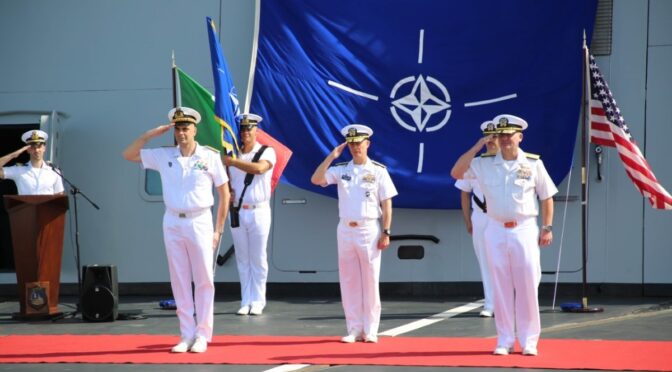By Dmitry Filipoff
Last week CIMSEC featured articles submitted in response to our Call for Articles on NATO Naval Power.
Authors explored a wide variety of themes and scenarios for the NATO alliance. How does NATO naval strategy evolve if the U.S. scales back its commitment and the Ukraine war rages on? How does the accession of Finland and Sweden change the maritime geography of NATO’s naval threat environment? How are allied nations deploying naval formations to the Indo-Pacific and contributing toward deterrence against China? NATO is at a historic inflection point and its future could take many directions.
Below are the articles and authors that featured during the topic week. We thank them for their excellent contributions.
“Parting Ways: A NATO Naval Strategy Without America,” by Paul Viscovich
“In this era of increasing danger, great power competition, and uncertain loyalties, the time has come for the North Atlantic Treaty Organization to declare its independence. As at the time of its founding, NATO’s strategic adversary is Russia. But unlike during the Cold War, the Alliance can no longer count on the military and industrial might of the United States in confronting the threat.”
“Maritime Security on NATO’s Southern Flank: The Case for a Spanish Coast Guard,” by Gonzalo Vázquez
“Following the example of many of its European and American allies in NATO, it is worth exploring the potential establishment of a Spanish Coast Guard that merges all these existing services under a single, professional service with a unified and clearly defined command structure.”
“The Case for a Baltic SNMG-3: Developing Regional NATO Forces at Sea,” by Steinar Torset and Ian Bowers
“NATO should create a third Standing NATO Maritime Group (SNMG) dedicated to operations in the Baltic. This would fully exploit the operational benefits of Finland and Sweden joining NATO and take advantage of ongoing force developments in other Baltic NATO navies, including Poland and Germany.”
“Keeping America Engaged: Three Possibilities for European Navies,” by Michael D. Purzycki
“To keep the U.S. engaged in the waters around Europe, European NATO members must find areas of common interest with the U.S. The threat of China to both European and American security interests creates many such opportunities. By monitoring China’s activities in the Arctic, becoming more active in the Indo-Pacific, and buying American, Europeans can maintain a strong military and industrial link to the U.S. even if U.S. military presence in and around Europe shrinks in the near future.”
“French Maritime Strategy – Carrier-Led and Indo-Pacific Focused,” by David Scott
“French maritime strategy has been on full public display with the deployment of the French Carrier Strike Group (CSG) from November 2024 to April 2025, carrying out an extended deployment across the Indo-Pacific in the furthest ever Operation Clemenceau.”
“Strengthening Unity of Effort in the Atlantic: Lessons from Wargaming,” by Walter Berbrick and Terence Nicholas
“By stress-testing command structures, exploring new approaches to force employment, and fostering greater integration between U.S. and NATO maritime forces, wargames have directly informed adjustments that enhance unity of effort across the Atlantic. These insights have helped refine coordination among key commands, sharpen deterrence, and improve readiness to respond to emerging threats in an increasingly complex security environment.”
“A Post-Mortem of the Red Sea Crisis: NATO versus the European Union,” by Anna Matilde Bassoli
“The disjointed approach of the U.S. and the European Union to the Red Sea Crisis deserves thorough analysis as a critical yet overlooked cause of transatlantic distress. Indeed, the issue between the transatlantic allies is not who has to bail out whom. Instead, the emergence of the European Union (EU) as a security actor in the maritime domain has weakened the U.S. grip on NATO’s naval strategy.”
Dmitry Filipoff is CIMSEC’s Director of Online Content. Contact him at Content@cimsec.org.
Featured Image: July 7, 2022 – U.S. Navy Rear Admiral Michael Sciretta assumes command of Standing NATO Maritime Group Two (SNMG2) at a change of command ceremony on board the Italian frigate Carlo Margottini in Taranto Naval Station in Puglia, Italy. (NATO photo)

